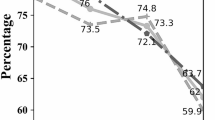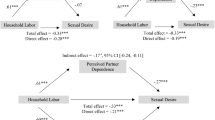Abstract
The extant literature shows that fertility desires are an important indicator for understanding and predicting the future course of fertility; however, little work has been done on its relationship to ethnicity among women in Ghana. Therefore, this study investigates the relationship between ethnicity and fertility desires among two groups of parous women in Ghana. Using 2014 Ghana Demographic and Health Survey data, analyses were conducted with 5548 women between ages 15 and 49 years. Respondents were divided into two groups: 1) women with 1–3 living children (n = 3437), and 2) women with 4 or more children (n = 2111), representing those with children below and above the wanted fertility rate, respectively. Descriptive analyses indicated that 77.5% of women in the lower parity group desired an additional child, whereas 23.6% of women in the higher parity group had the same desires. Binary logistic regression results showed that ethnicity was a significant predictor of fertility desires among the two groups of women. Additionally, ethnicity remained significant when socio-economic factors were controlled for. The study’s findings refute the characteristics hypothesis, signifying that even though certain ethnic groups are assimilated into more modern socio-economic structures, they still maintain their pronatalistic beliefs. More specifically, Mole-Dagbani and “Other” women, who already have a high parity, are more likely to want an additional child. Further qualitative work is required to understand the norms, customs, practices, and beliefs that govern the major Ghanaian ethnic groups regarding their fertility desires and behaviour.
Similar content being viewed by others
Data availability
The 2014 Ghana Demographic and Health Survey data are available at dhsprogram.com.
Notes
Patrilineal Akans are known to reside in Mampong, Eastern Region, however, they comprise a minority and tradition suggests that they derive roots from the Guans.
Frequencies were run with the 577 undecided women and findings indicate them to be similar to the women used for the final analysis on key variables. Slight differences were seen with regards to the wealth of 1–3 parity women who had higher proportions in the middle and richer groups and a smaller proportion in the richest group. In addition, those with no partners were a slightly higher percentage for both groups of women.
References
Addai, I. (1999a). Ethnicity and contraceptive use in Sub Saharan Africa: The case of Ghana. Journal of Biosocial Science, 31(1), 105–120.
Addai, I. (1999b). Ethnicity and sexual behaviour in Ghana. Social Biology, 46(1–2), 17–32.
Addai, I., & Trovato, F. (1999). Structural assimilation and ethnic fertility in Ghana. Journal of Comparative Family Studies, 30(3), 409–427.
Agyei-Mensah, S. (2006). Fertility transition in Ghana: Looking back and looking forward population. Space and Place, 12(461), 477. https://doi.org/10.1002/psp
Awusabo-Asare, K. (1990). Matriliny and the new intestate succession law of Ghana. Canadian Journal of African Studies, 24(1), 1–16.
Bankole, A. (1995). Desired fertility and fertility behavior among the Yoruba of Nigeria: A study of couple preferences and subsequent fertility. Population Studies, 95(2), 317–328.
Bawah, A. A., Akweongo, P., Simmons, R., & Phillips, J. F. (1999). Women’s fears and men’s anxieties: The impact of family planning on gender relations in Northern Ghana. Studies in Family Planning, 30(1), 54–66.
Becker, G. S. (1960). An Economic analysis of fertility, demographic and economic change in developed countries: A conference of the universities. National Bureau of Economic Research (pp. 209–231). Princeton.
Becker, G. S., & Lewis, H. G. (1973). On the interaction between the quantity and quality of children. Journal of Political Economy, 81(2), S279–S288.
Biney, A. A. E., Wright, K. J., Kushitor, M. K., Jackson, E. F., Phillips, J. F., Awoonor-Williams, J. K., & Bawah, A. A. (2021). Being ready, willing and able: Understanding the dynamics of family planning decision-making through community-based group discussions in the Northern Region Ghana. Genus, 77(1), 1–23.
Bleek, W. (1990). Did Akan resort to abortion in precolonial Ghana? some conjectures. Africa, 60, 121–132.
Cardwell, M. E., Soliz, J., Crockett, L. J., & Bergquist, G. L. (2020). Critical incidents in the development of multiethnic racial identity Experiences of individuals with mixed ethnic racial backgrounds in the U.S. Journal of Social and Personal Relationships., 37(5), 1653–1672. https://doi.org/10.1177/0265407520906256
Casterline, J. B., & Agyei-Mensah, S. (2017). Fertility desires and the course of fertility decline in sub-Saharan Africa. Population and Development Review, 43(2008), 84–111. https://doi.org/10.1111/padr.12030
Colleran, H., Jasienska, G., Nenko, I., Galbarczyk, A., & Mace, R. (2015). Fertility decline and the changing dynamics of wealth, status and inequality. Proceedings of the Royal Society B: Biological Sciences, 282, 20150287. https://doi.org/10.1098/rspb.2015.0287
Conteh-Khali, N. (2014) Socio-economic and cultural factors influencing desired family size in Sierra Leone. Unpublished PhD Dissertation. Bowling Green State University. Retrieved from https/etd.ohiolink.edu/
Ekane, D. (2016) Female education and fertility desires in Cameroon. Unpublished Master’s Thesis. Stockholm University.
Falola, T. (2001). Culture and customs of Nigeria. United States: Greenwood Publishing Group.
Gaisie, S. K. (1968). Social structure and fertility in Ghana. Ghana Journal of Sociology, 2, 88.
Garenne, M. (2008). Fertility change in sub-Saharan Africa, DHS comparative reports no 18. Calverton, MD: Macro International Inc, United States.
Ghana Statistical Service (GSS). (2012). 2010 Population and housing census. Ghana Statistical Service, Accra: Summary Results of Final Report.
Ghana Statistical Service (GSS), Ghana Health Service (GHS), & ICF International. (2015). Ghana Demographic and Health Survey 2014. Rockville, Maryland, USA: GSS, GHS, and ICF International.
Ghana Statistical Service (GSS), Ghana Health Service (GHS), & ICF. (2018). Ghana Maternal Health Survey 2017. Accra, Ghana: GSS, GHS, and ICF.
Goldscheider, C. (1971). Population, modernization, and social structure. Little, Brown and Company.
Kaye, B. (1962). Bringing up children in Ghana: An impressionistic survey. Allen and Unwin.
Khan, R., Ali, E., & Bari, K. M. (2014). Revealing ideal number of children by women: A socioeconomic analysis using Pakistan demographic and health survey. Pakistan Journal of Commerce and Social Sciences, 8(3), 887–899.
Kollehlon, K. T. (1989). Ethnicity and fertility in Liberia: A test of the minority group status hypothesis. Social Biology, 36(1–2), 67–81.
Mashara, J. N. (2016). Factors influencing fertility preference of currently married men in Kenya. African Population Studies, 30(2), 2431–2443.
Mekonnen, W., & Worku, A. (2011). Determinants of fertility in rural Ethiopia: The case of Butajira demographic surveillance system (DSS). BMC Public Health, 11(1), 782. https://doi.org/10.1186/1471-2458-11-782
Muhoza, D. N., Broekhuis, A., & Hooimeijer, P. (2014). Variations in desired family size and excess fertility in East Africa. International Journal of Population Research. https://doi.org/10.1155/2014/486079
Nahmias, P. (2007) The importance of ethnicity: fertility and ethnicity in West Africa. Unpublished Thesis. Princeton University.
National Population Council. (1994). National Population Policy of Ghana. Accra, Ghana: Government of Ghana & National Population Council. https://www.npc.gov.gh/wp-content/uploads/2019/01/National-Population-PolicyRevised-Edition-1994.pdf
Opoku, G. (2014). Fertility preference and contraceptive use in rural and urban communities in the Asunafo North District of the Brong Ahafo Region. Unpublished PhD Dissertation. Kwame Nkrumah University of Science and Technology, Ghana.
Orbeta, A. C. (2005). Poverty, Vulnerability and Family Size: Evidence from the Philippines, ADBI Research Paper Series, No. 68, Asian Development Bank Institute (ADBI), Tokyo. http://hdl.handle.net/11540/4174
Palamuleni, M. E. (2014). Social and economic factors affecting ethnic fertility differentials in Malawi. International Journal of Development and Sustainability, 3(1), 70–88.
Pullum, T. W. (1980). Illustrative analysis; fertility preferences in Sri-Lanka. A World Fertility Survey Scientific Report. International Statistical Institute. Voorsburg.
Sennott, C., & Yeatman, S. (2012). Stability and change in fertility preferences among young women in Malawi. International Perspectives on Sexual and Reproductive Health, 38(1), 34–42.
Susuman, A. S., Bado, A., & Lailulo, Y. A. (2014). Promoting family planning use after childbirth and desire to limit childbearing in Ethiopia. Reproductive Health, 11(1), 53. https://doi.org/10.1186/1742-4755-11-53
Tadesse, B. & Asefa, S. (2001). Are more children a blessing? Determinants of the demand for children in Jimma, Ethiopia. International Conference on African Development Archives. Paper 33. http://scholarworks.wmich.edu/africancenter_icad_archive /33.
Wawire, S. N., Jensen, A-M. & Mumah, J. N. (2013) Differences in fertility desires between men and women: The role of gender context. Paper presented at the annual Population Association of America Meeting, Louisiana, April 11–13, 2013.
Funding
No funding was received for this study.
Author information
Authors and Affiliations
Contributions
All authors contributed to the study conception. Data analysis was performed by the first author who also drafted the initial manuscript, which was adapted from his unpublished Master’s dissertation. All authors commented on and revised subsequent versions of the manuscript and approved the final manuscript.
Corresponding author
Ethics declarations
Conflict of interest
The authors declare that they have no competing interests.
Additional information
Publisher's Note
Springer Nature remains neutral with regard to jurisdictional claims in published maps and institutional affiliations.
Rights and permissions
About this article
Cite this article
Akonor, N.O., Biney, A.A.E. Ethnicity and fertility desires in Ghana. J Pop Research 38, 283–306 (2021). https://doi.org/10.1007/s12546-021-09266-0
Accepted:
Published:
Issue Date:
DOI: https://doi.org/10.1007/s12546-021-09266-0




